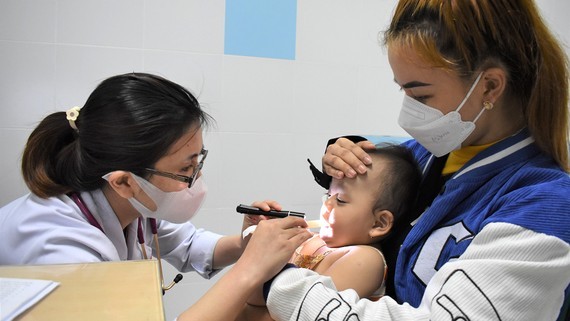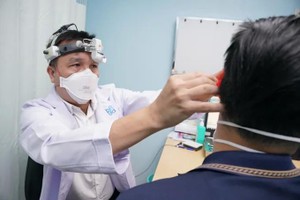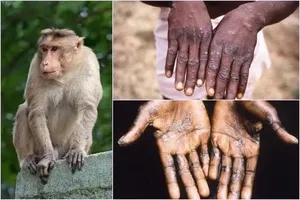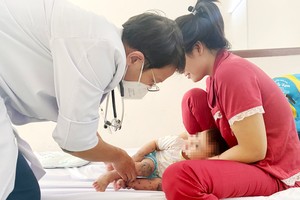 A doctor examines a baby
A doctor examines a baby
A 2-year-old baby temporarily residing in Ward 25 in Ho Chi Minh City’s Binh Thanh District was taken by her mother to Children's Hospital 2 on July 3 when the baby was experiencing fever and rash in the mouth. Three days before, her mother thought she had a sore throat, so she did not take her to the hospital, but only treated her at home. However, the baby’s illness has shown no signs of abating but had a high fever, fatigue, lethargy, sore hands and feet, lots of pimples in the mouth, unable to eat, the mother rushed to take her child to the hospital where doctors diagnosed the toddler as having severe hand-foot-and-mouth disease.
Dr. Nguyen Dinh Qui, in charge of managing the Infection Department, Children's Hospital 2, said that from May 1 to the end of July 3, the hospital recorded 6,635 cases of hand, foot, and mouth disease, in the period from May 1 to July 3 and about 40 percent of them are city children, the rest are scattered in neighboring provinces. This shows that the number of children with hand, foot and mouth disease is increasing gradually.
Most children are admitted to the hospital with fever for many days in a row, accompanied by red blisters on hands and feet, even sores in the throat, which interfere with the child's eating and drinking.
Dr. Qui revealed that through talking with parents, he realized that many people still have misconceptions about this disease when taking care of children, making the condition worse.
Dr. Tran Van Khanh, Director of Le Van Thinh Hospital in Thu Duc City, added that over the past time, the infirmary has received treatment for about 100 cases of hand, foot, and mouth disease. Nearly 7 percent of children had to be hospitalized for treatment. Hand, foot and mouth disease is not a new disease, but many parents have used methylene blue (an antiseptic applied to the skin), unintentionally covering up the symptoms, leading to delayed diagnosis and difficult monitoring of disease status.
Worse, some families also apply herbs, leaves, or floating drugs with unknown medicinal ingredients, which are very dangerous for children. Some people think that when children have hand, foot, and mouth disease, the more they incubate the child, limit bathing, and let the child have a rash, the faster it will heal. But this is a completely wrong concept because if the child is incubated too much, the child will have a skin infection, and leave scars, while taking care of a child with hand, foot and mouth disease, it is necessary to keep the rash clear to be able to heal and leaves no scars.
According to the Ministry of Health, from the beginning of 2022 until now, the country has recorded nearly 6,000 cases of hand, foot and mouth disease including one death. Most cases of HFMD are living in Ho Chi Minh City, and the southern provinces of Dong Nai, Binh Duong, Soc Trang, and Ca Mau.
In Ho Chi Minh City, 95 percent of children with hand, foot and mouth disease are between the ages of 1 and 12. The disease increased in both the group of pediatric patients admitted to the hospital for inpatient treatment and outpatient care. Districts 12, Binh Tan, Go Vap, Tan Binh, Hoc Mon outlying district and Thu Duc City have seen an alarming number of HFMD cases.
According to Associate Professor Do Van Dung, Dean of the Faculty of Public Health under the University of Medicine and Pharmacy in Ho Chi Minh City, hand, foot, and mouth disease is caused by viruses that belong to the Enterovirus family. A person infected with one of these viruses is contagious, which means that they can pass the virus to other people.
The virus can spread to others through an infected person’s nose and throat secretions, such as saliva, drool, or nasal mucus and fluid from blisters or scabs. This is why it often affects toddlers: Kids in this age group often touch other children or share toys and then put their hands in their mouths. Symptoms of hand, foot, and mouth disease usually include fever, mouth sores, and skin rash. The rash is commonly found on the hands and feet.
To date, there is no specific drug to treat. Hand, foot, and mouth disease is mainly treated with symptoms such as reducing fever, relieving pain caused by ulcers, and treating complications if any. For mild cases, only pain relievers and sedatives are needed.
However, children need to be closely monitored to promptly handle possible complications. The disease will go away on its own after a few days, and the red spots will go away, leaving no scars; but if the cause of the disease is Entero 71 virus (the causative agent of encephalitis, hand foot and mouth disease), it can lead to death due to complications of encephalitis, meningoencephalitis, myocarditis, pulmonary edema without timely treatment.
























